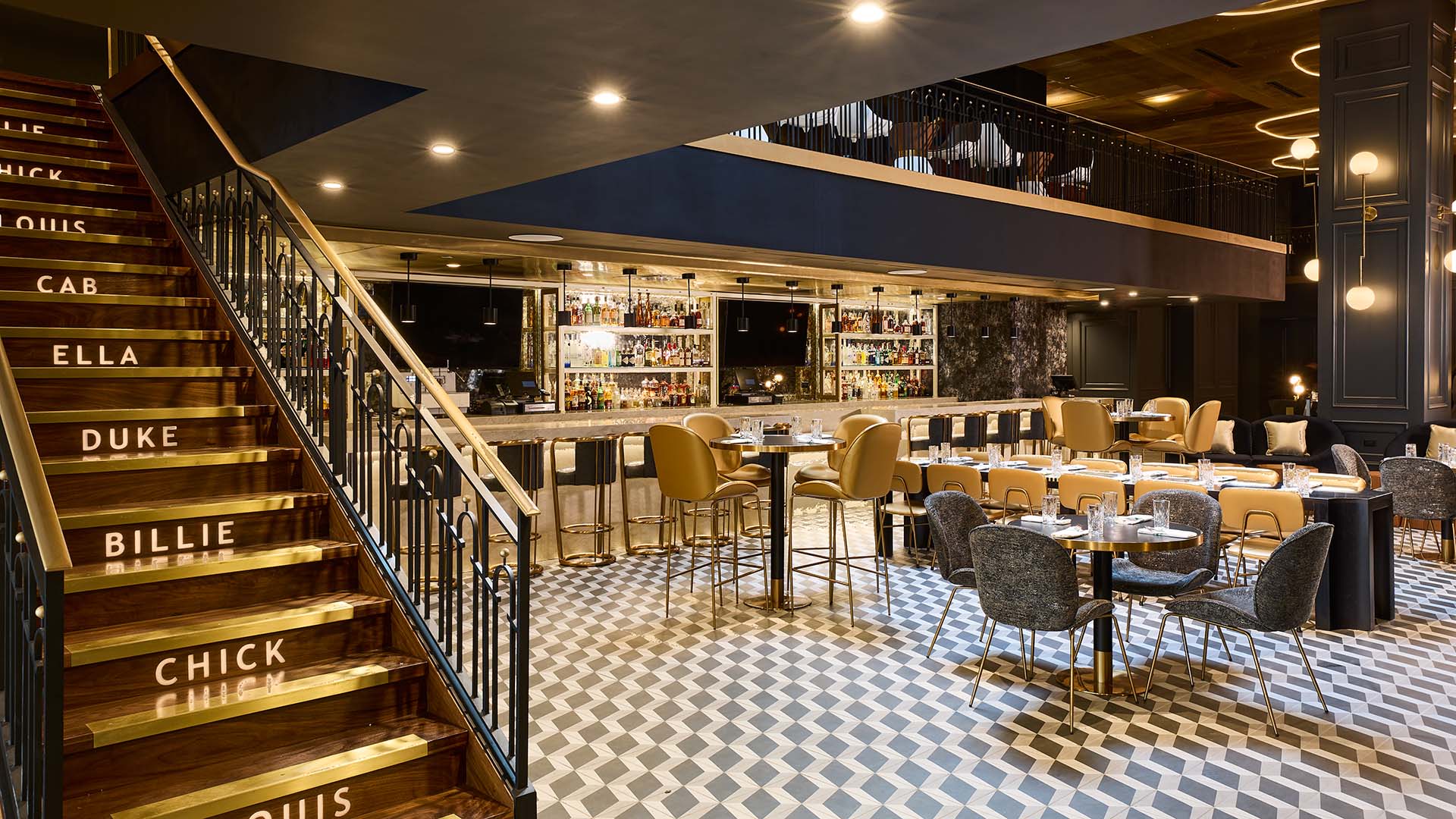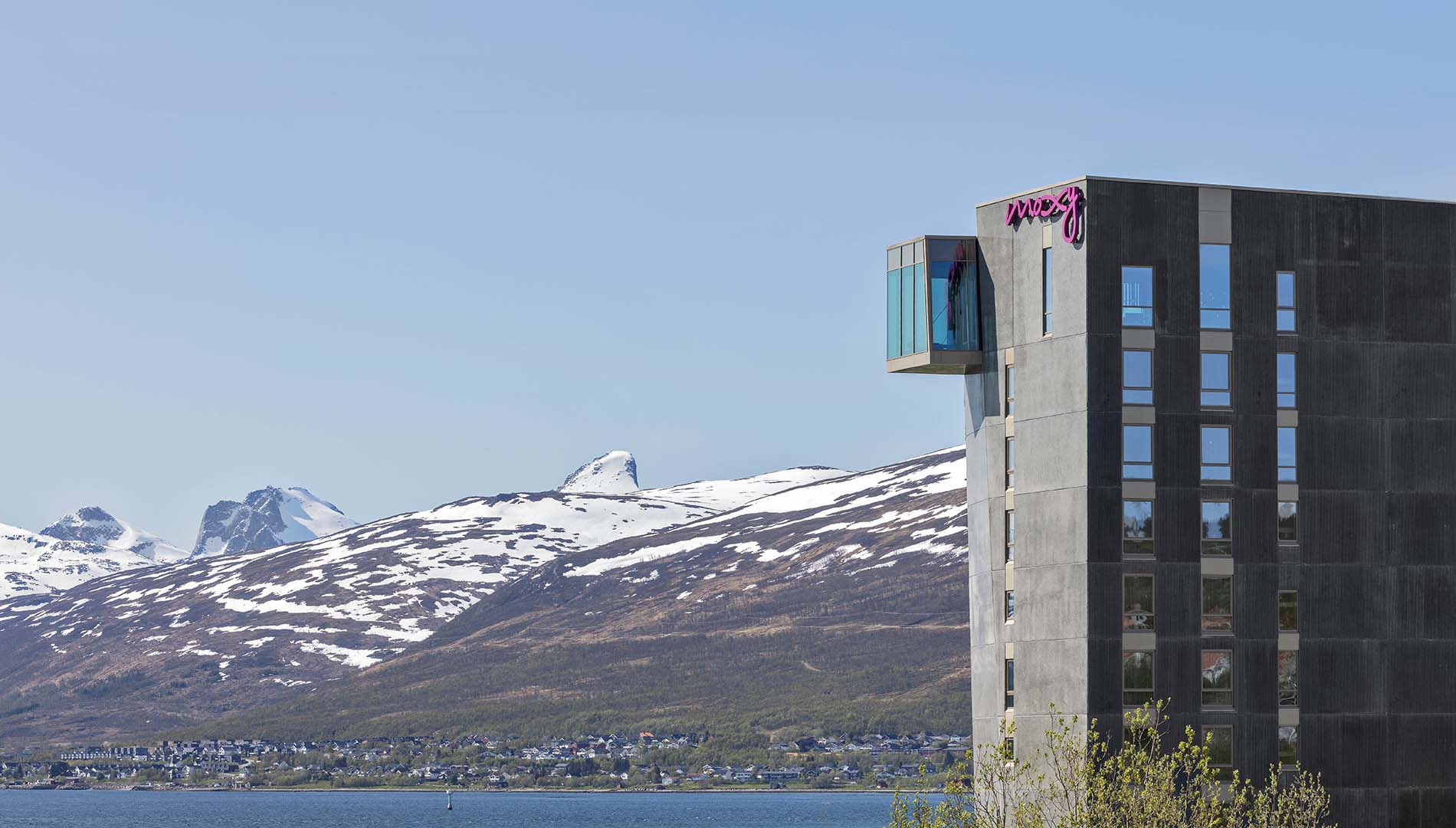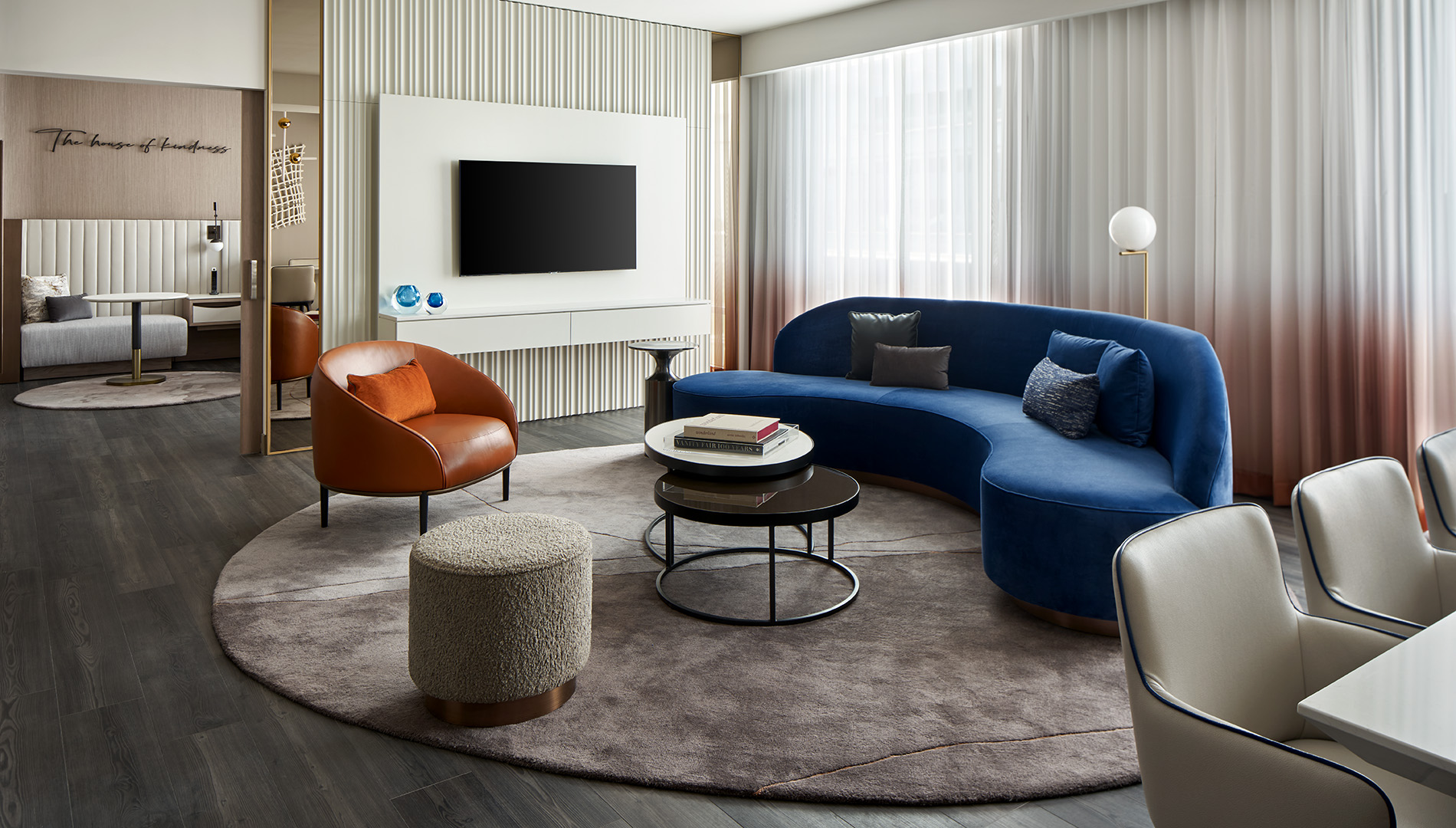
Book a sleek suite at Marriott Bethesda Downtown at Marriott HQ in Bethesda, Maryland. (Photo: Marriott International)
Travel by DesignDesigning a New Generation of Hotel Rooms at Marriott’s Innovation Lab
By Hamish KilburnWhat can travelers expect from the next generation of hotel rooms? To find out, Hamish heads to the top secret innovation lab at Marriott Headquarters — where more adaptable, interactive, and locally connected hotel rooms are being crafted as the ideal home base for millions of travel journeys to come.
He learns why the near future of hotel rooms isn’t a dogpile of technology for technology’s sake. Instead, it’s a future where we can adjust our room to be what we need right in the moment, by pressing a single button or pulling on a single handle.
In this episode, Hamish gets a glimpse of that future by going behind the scenes at a massive workshop, where (with the help of a power saw, foamcore, and VR headsets) new ideas can become new hotel rooms in a single day. Then, just across the street he explores an entire floor of prototype rooms, where travelers are invited to stay the night and help shape their final form.
And along the way, Hamish meets the passionate designers who strive to help travelers get immersed in their destination — and walk away from every trip with a feeling of perpetual discovery.
Featured Hotel: Marriott Bethesda Downtown at Marriott HQ
Featured Designer: Jeff Voris, Senior Vice President of Global Design Strategies at Marriott
Explore more stories about hotel design at Travel by Design
Follow host Hamish Kilburn’s hotel design reviews @HotelDesigns
TRANSCRIPT
AMBI: Elevator voice says “Going up,” and sounds of the elevator duck under Hamish’s narration
HAMISH VO: I’ve just checked into the Marriott Bethesda Downtown hotel.
Hamish Kilburn: (To other guests in the elevator) Do you love lift music?
MUX Starts — “Smoove” by Jobii
HAMISH VO: And I’m heading up to my room — which has a brand new design that I’ve been invited to test out.
I’ll be honest, though. I’m jet lagged … I’ve traveled for about 9 hours and crossed about 5 time zones. I’ve got work tomorrow, and I just want to lie down.
AMBI: Elevator voice says, “4th floor,” and doors close
HAMISH VO: But then I see Jeff Voris, the Senior Vice President of Global Design Strategies at Marriott. He’s standing outside my room, and he’s got a grin on his face.
Jeff Voris: Hamish! Welcome.
Hamish Kilburn: Hey Jeff, how you doing?
Hamish Kilburn: So, are we ready?
Jeff Voris: Let’s do it!
AMBI: Door opens and closes
Hamish Kilburn: Okay, so we’ve walked into the room, and I can straightaway see an area for the dining table, there’s a statement lighting piece, really nice wall coverings, spacious living area …
MUX Fades away
Hamish Kilburn: It — something doesn’t feel right, though, about this space. I can’t … what … (bewildered) where’s the bed?! (Laughs)
Jeff Voris: Exactly.
Jeff Voris: Uh, if you’ll touch the panel just on the wall there, to your left …
Hamish Kilburn: Oh. (Giggles)
AMBI: A motorized, whirring sound
Hamish Kilburn: It’s, it’s a bed. Literally coming from the ceiling.
It looks like it’s going to crush the sofa, but I’m assuming it’s not … (Laughs heartily)
Jeff Voris: It does look like that; I assure you, it won’t!
Hamish Kilburn: Okay, that’s really clever. So the sofa becomes the headboard.
Jeff Voris: That’s exactly right.
Hamish Kilburn: I mean, I’ve reviewed a lot of hotels and seen a lot of hotel configurations and concepts, and I’ve never experienced the bed coming down from the ceiling.
Hamish Kilburn: When did this concept come to you guys?
Jeff Voris: What we took as inspiration is some guest insight that said: The way you experience a space isn’t necessarily by square footage …
Hamish Kilburn: Mm-hm?
Jeff Voris: But rather by circulation space.
Hamish Kilburn: Mmm.
Jeff Voris: Well, how do we maximize circulation space? So we thought, “Okay, well, then, let’s get rid of the bed.”
AMBI: The same motorized, whirring sound the bed made as it descended
Hamish Kilburn: Oh wow.
Jeff Voris: And now the bed will raise itself into the ceiling …
Jeff Voris: The notion being: We could change the purpose of a room over time, to let it be what you want in each moment.
Hamish Kilburn: Hm. And do you think this is the future of hotel rooms?
Jeff Voris: I think it’s a future. I think this is one arrow in our quiver.
Show Open
MUX Returns in full
HAMISH VO: This is Travel by Design, where we chat with the visionaries behind the world’s most extraordinary hotels.
I’m your host, Hamish Kilburn, professional hotel reviewer and the editor of Hotel Designs.
And today, our destination is Marriott Headquarters, in Bethesda, Maryland — where Jeff, and his team of designers, have built an entire floor of prototype hotel rooms.
Many of these next-generation rooms are made to become what I need, when I need it. In a very tangible, and intuitive way.
But how do you take something like a disappearing bed, and make it feel totally natural, and completely essential, the first time it’s used?
And how do you make a room that works for all kinds of travel journeys … without losing the personality of the place you’re traveling to?
MUX Ends
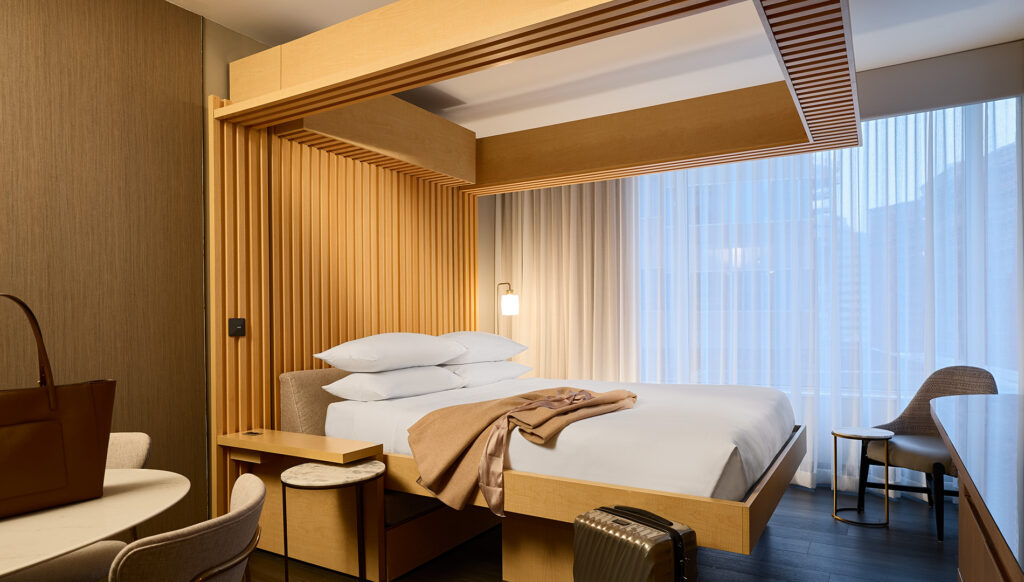
Act 1: Where Future Hotel Rooms Are Born
AMBI: A low, motorized humming sound
HAMISH VO: To find out, I follow Jeff to the place where future hotel rooms are born.
AMBI: The sound of high pressure being released
HAMISH VO: We’re in the maker space at Marriott’s top secret design lab.
It’s a massive workshop, where the team can build a test room in a single afternoon.
AMBI: Sound of a power saw
HAMISH VO: The first version of a new room is made entirely of out plain white foam core, and it’s filled with real furniture.
AMBI: Sound of duct tape peeling
Jason Robertson: There’s lots of things that you can do digitally that feel very different — you change a wall a couple inches? It can feel VERY different when you get into the physical space.
AMBI: Jason’s voice ducks under Hamish’s narration
HAMISH VO: That’s Jason Robertson, Vice President of Global Design Innovation. He steps into the bare-bones room, and he is literally talking to me through the fourth wall.
Jason Robertson: So, uh, you can put on a headset that can show you what the finished product could look like, you can stand in this unfinished room, and you can feel like you’re in the space, but you can be seeing what the final version of it is.
The ability to sit in that space is really critical. We all have a sense called proprioception, and that’s why you know a space feels claustrophobic or expansive, and that’s important to get to really quickly, because inches matter in our business and, and that tension between things.
Hamish Kilburn: To actually feel, because that’s what we’re trying to do, isn’t it? Allow guests to really feel something as they walk into a space.
Jason Robertson: Yeah, the reality is, often people don’t know what they want until they see it, and so it’s this team’s job to create that vision for the future, to bring that new thing to life, so that when guests do see it, they know it’s instantly what they want.
Act 2: Testing the Next Generation of Rooms, Today
MUX Starts — “Sky Filled With Treasure” by Aiyo
HAMISH VO: So to find out how travelers will react to these new designs, the team is building an entire floor of prototype rooms next door, in the Marriott Bethesda Downtown Hotel.
Jeff walks over to an unmarked door, and he brings me into the secret corridor where these rooms are being set up.
Hamish Kilburn: Oh, I can smell it. I can smell that there’s construction happening in this area.
Jeff Voris: There’s absolutely construction still happening.
AMBI: Jeff’s voice ducks under Hamish’s narration
HAMISH VO: Even though we’re only a few stories up, Jeff calls this place “Floor 57.”
Jeff Voris: Our first hotel was opened in 1957, so this is a space where we innovate on hotel rooms specifically.
HAMISH VO: All of this used to be two stories below Marriott headquarters. And it was called “The Underground.”
Jeff Voris: What I found is, I would periodically go down multiple days a week and work from those rooms, just to get the experience of being in and working in all these different rooms …
HAMISH VO: Now, these rooms are upstairs, and fully functioning.
Each door on Floor57 is marked with a brand name — like Westin, AC, or Moxy.
And behind every door there’s a prototype room for that brand. 13 rooms in total.
The design team invites travelers, journalists, hotel owners, and hospitality professionals to stay the night.
MUX Ends
Jeff Voris: And then at the end of their stay, we’ll invite them to do a debrief with us, to give us their feedback on what they experienced.
Hamish Kilburn: So it’s not just a questionnaire, it’s actually a conversation that you’re having with the guests to really understand how that space made them feel.
Jeff Voris: Most definitely. We are not probably as good interviewers as you are …
Hamish Kilburn: (Chortles) Please …
Jeff Voris: … but our goal is to pull the, pull that information from the guest, right? To have a conversation with them and notice where there’s the pause or notice where there’s the hook to ask another question, and to pull it forward.
AMBI: Sounds of Jeff and Hamish chatting duck under Hamish’s narration
HAMISH VO: Like the disappearing bed in my room, the most impressive features are the things that I can reach out and touch.
There’s a sofa in the Westin, which changes shapes with a simple push or pull of the side cushion.
Jeff Voris: You can turn the arm of the sofa. It goes from a back to an arm, which allows you to sit in different positions as you work or relax.
HAMISH VO: Jeff shows me an enormous vanity mirror in the AC, that’s standing where normally, there’d be an entire wall.
Jeff Voris: That mirror does act as a divider, but it’s also very ephemeral. It doesn’t feel heavy. It doesn’t take up a bunch of space, and if you come around to the bedside of it, you’ll notice that that space behind the mirror is taken up by this piece, which is effectively an art piece, but it’s also a reflector, which allows light to get diffused through the room.
Hamish Kilburn: Yeah, it’s clever.
HAMISH VO: And in the Moxy, I see three paintings, which actually turn out to be loose leaf pads — and each page is a replica of the original artwork.
Jeff Voris: … which allows you as a guest, if you like that art, we want you to like it, then you can now take that off and take it home with you.
Hamish Kilburn: So you just rip it off? Like …
Jeff Voris: Absolutely.
AMBI: Hamish tears a large sheet of paper off the pad
Jeff Voris: And now that’s yours to take home.
Hamish Kilburn: Even the room that I’m staying in tonight, has the, the movable bed, and …
It’s interesting to me actually seeing physical objects based on research, and there being a bigger picture and actually seeing it as a tangible solution.
And for you, as a design visionary, what are you trying to give to hospitality and the next generation of hotels?
Jeff Voris: As I travel, for me one of the things that really attracts me to it is this notion of perpetual discovery, of always finding something new, and when you come to a new city, it’s the idea of discovering what that city’s about what the people there about, but it’s also about discovering yourself, discovering who you are in this moment how you are what it is you want, and how we deliver that to you in the best possible way, so …
How do we give you that sense of wonder and that feeling of discovery?
Act 3: Design That Helps You Discover Your Destination
MUX Starts — “LUB” by Amaroo
HAMISH VO: This idea, of perpetual discovery, really resonates with me.
Because when I travel, what I want most of all from a hotel room, is that it just makes my trip feel seamless, and brings me closer to the place I’m visiting.
Aliya: Imagine how soul crushing it is for many when you wake up in a room and you’re like, I don’t know where I am, I have no sense of place, and how sad that you leave without having even just a tad, a smidge of insight into — what is it about this destination, you know?
HAMISH VO: That’s Aliya Khan. She’s a Vice President of Design at Marriott.
And she’s helping me see how these next-generation rooms can be flexible for different styles of travel, but without becoming totally bland.
We’re standing inside the prototype room for Le Meridien. It’s a comforting, elegant space that she’s filled with visual details, from the history of Bethesda.
Aliya Khan: So the story or the narrative that was put together was around the sort of agrarian roots of Maryland, pulling the color palette from what that might look like …
HAMISH VO: There’s a map woven into the carpet, which shows the topography of the surrounding area. And framed paintings on the wall, which were curated in partnership with local artists.
Aliya thinks there’s so much more she can do with design, to help us discover the meaning of the journeys that we’re on.
MUX Ends
Aliya Khan: I’m looking forward to a world where I think we can really invest in local communities.
So for example, this artwork, these three pieces, each one is a young, underrepresented artist from the area.
To share their work, for us to show insight into a new point of view is quite exciting, and so, you know, why does it just begin with art?
Is it something about the food? Is it something about the culture? Is it something about the art?
You know, even a botanical can go so far in conveying something about where you are, and it should look good, but if someone wants to dig deeper, imagine how much more pleasurable it is to learn that deeper meaning.
Hamish Kilburn: Totally.
Aliya Khan: Because if they’re picking you, I kind of feel you have to be willing to give back something that is super meaningful to them.
These are birthdays and anniversaries, you know, memorable, iconic life experiences, so what are we doing in the design to make it memorable, make it unique, make it like nothing other?
I think those are sort of the things that inspire me, and …
MUX Begins — “Overlander” by Steven Gutheinz
Aliya Khan: You know, you can then regularly think about, like, “Well, we’ve done that before, let’s not do that again.”
Or, “We did that, we learned something from it. How do we evolve it further?” And I think all of those conversations drive what we do.
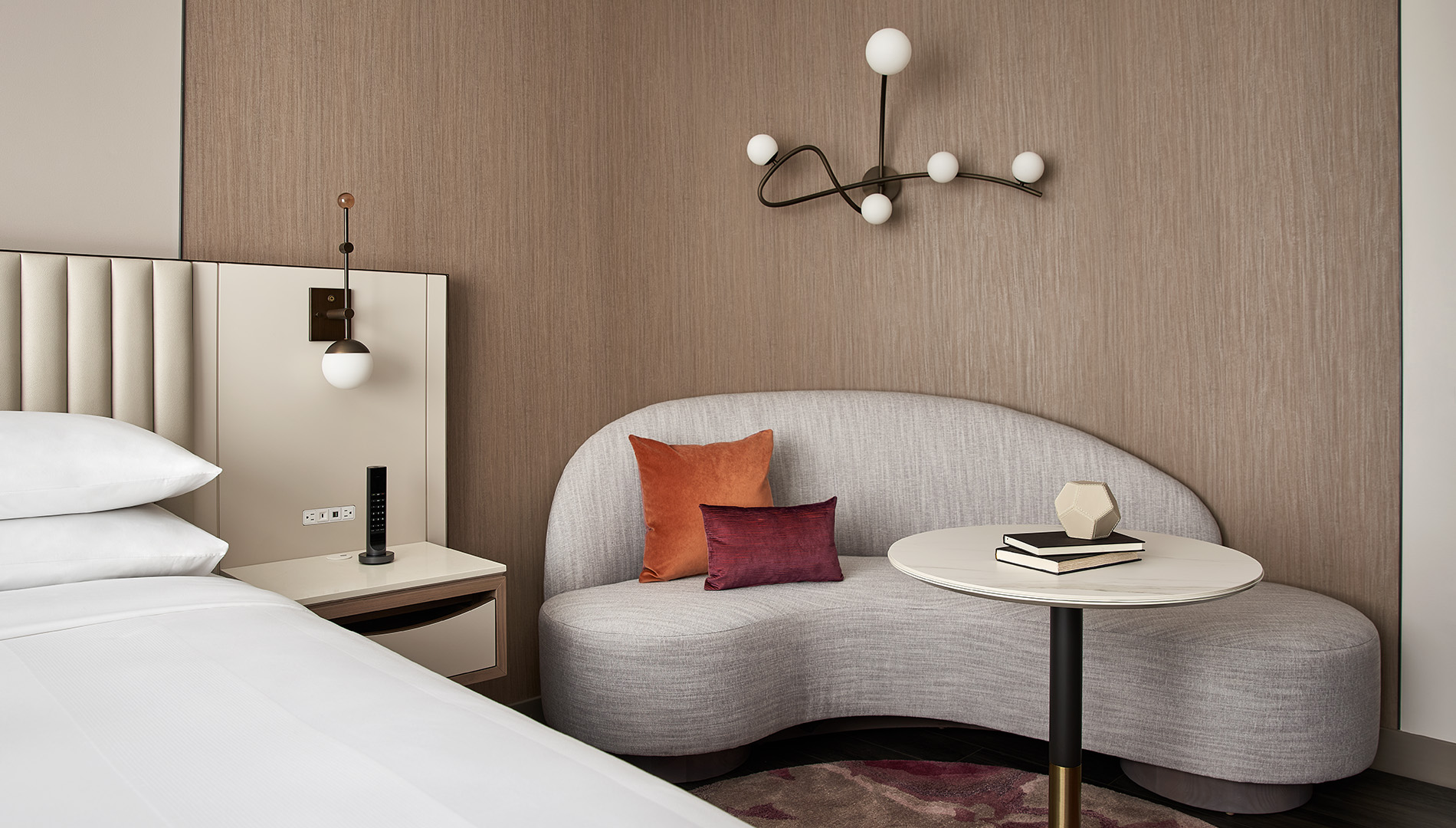
Credits
HAMISH VO: Travel by Design is a podcast by Marriott Bonvoy Traveler, the online travel magazine where you’ll find more inspiring hotel design stories.
If you’re curious about the craft of hotel design, then check out marriottbonvoy.com/travelbydesign.
And if you want to go behind the scenes of my travel experiences across the world, then follow me on Instagram @hotel_travel_editor.
This episode was produced by Narratively Creative. Our Senior Producer is James Boo. Our Associate Producers are Nidhi Shastri and Greta Stromquist.
Story edits by Priscilla Alabi, sound design by James Boo — and audio engineering by Dorian Love.
Our Marriott Bonvoy Traveler producers are Valerie Conners and Robin Bennefield.
Special thanks to Jeff Voris, Jason Robertson, Robyn Kaminsky, Debbie Hughely, Aliya Khan, and Mike Pozdal, for speaking with me about their work.
And thank you to Kelly Lavin for making my trip to Marriott headquarters possible.
I’m your host, Hamish Kilburn. Don’t forget to subscribe to Travel by Design wherever you get your podcasts. And tune in next time to hear more design stories behind the world’s most extraordinary hotels.
MUX Ends







